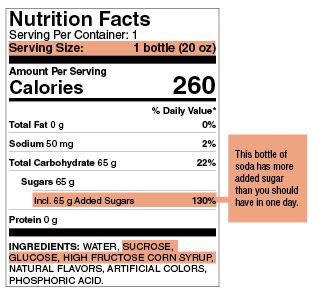Play Every Day Blog Update: Finding added sugar is easier with the new Nutrition Facts label
Alaska Department of Health sent this bulletin at 12/18/2019 08:40 AM AKSTFinding added sugar is easier with the new Nutrition Facts label

DECEMBER 18, 2019 — Have you ever wanted to know how much added sugar is in your yogurt, breakfast cereal or beverage? Starting Jan. 1, 2020, you can know the answer by reading the new line on the Nutrition Facts label called “Includes Added Sugars.”
After more than 20 years, this label is getting a makeover. The U.S. Food and Drug Administration (FDA) is updating the Nutrition Facts label with the new line for added sugars and other changes to make sure families have access to useful and accurate nutrition information about the foods and drinks they’re consuming.
You may have already seen the new label on packages, but large food and drink companies need to update their labels by Jan. 1.
“The new label is definitely easier to read,” said Jennifer Johnson, Registered Dietitian Nutritionist with the State of Alaska Family Nutrition Program. “The big change is the ‘Added Sugars’ line. That will be so helpful for people trying to reduce the amount of added sugar they’re consuming for better health.”
Look for changes on the label
With the old label, it was impossible to know how much sugar was found naturally and how much sugar was from added sweeteners. Added sugars include those sugars that are added during the processing of foods and drinks, such as white table sugar (sucrose), brown sugar, high fructose corn syrup and honey. For example, plain white milk has lactose, a natural sugar, but not added sugars. Similarly, 100% fruit juice has fructose, a natural sugar, but not added sugars. On the other hand, chocolate milk contains both natural lactose and added sugars, such as high fructose corn syrup or sucrose. Fruit-flavored drinks can contain a small amount of natural fructose and a large amount of added sugars.
The new, updated label lists grams of added sugars on a separate line under “total carbohydrates.” The new Nutrition Facts label will help families see exactly how many grams of sugars have been added to their foods and drinks.
Guidelines recommend limiting daily added sugar
Added sugar typically means extra calories, but little or no healthy nutrients. People can fill up on sugary foods and drinks rather than eating other, healthier foods. Too much added sugar can lead to cavities, unhealthy weight gain, and type 2 diabetes — even in young kids.
For the best health, the U.S. Dietary Guidelines for Americans recommend limiting the amount of sugar you eat and drink to less than 10 percent of daily calories. For example, a 4-year-old child should limit added sugar to about 32 grams each day. There are four grams of sugar in each teaspoon of sugar, so the recommended limit for this child is fewer than 8 teaspoons of added sugar each day.
Just one drink can take children — even adults — over that daily sugar limit. For example, a 10-ounce fruit drink with 8 teaspoons of added sugar has more sugar than little kids should have in one day. Just one 20-ounce soda with 65 grams (16 teaspoons) of added sugar has more sugar than most children and adults should have in a day.
New label also changes serving sizes
The new Nutrition Facts label is also changing serving sizes and servings per container. These are now based on the amount of food that people typically eat at one time, which is usually more than the old suggested serving amount. For example, a 20-ounce bottle of soda will be labeled as one serving, since people are likely to drink the whole bottle at one time. Be sure to check the serving size and the number of servings per container when comparing calories in different foods or determining the amount of sugar in a drink.
The Nutrition Facts label helps families make informed decisions about the foods and beverages they eat and drink. The updated label will make it easier to choose foods and drinks that contribute to lifelong healthy eating habits.
Go online to learn more
- See the changes to the Nutrition Facts label on the FDA Nutrition Facts label website.
- Learn how to calculate the number of teaspoons of sugar in a drink and see the many names for added sugars on the Play Every Day website.
- Find some fun resources for teaching kids ages 9-13 how to read labels with the FDA “Read the Label” campaign.
Play Every Day is a campaign with the Alaska Department of Health and Social Services to help Alaska children grow up at a healthy weight and encourage families to be physically active and choose healthy drinks. For more information, visit www.playeveryday.alaska.gov.

